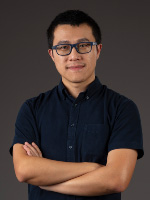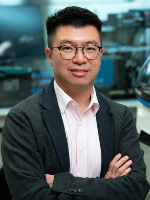
The first-ever Asian Young Scientist Fellowship Annual Conference, co-hosted by The University of Hong Kong in October 2023, was designed to showcase the work of some of Asia’s most exciting young research scientists and their vision for the future in their fields.
Bringing together 12 young scientists from China, Japan, Korea and Singapore to present their findings and engage in interdisciplinary dialogue, it was a window into emerging thinking in the region across the life sciences, physical sciences, mathematics and computer science.

As AYS fellow and participant Yi Yang said, it gave him the chance to share ideas with peers and senior scientists in a way not normally possible.
“By doing this event, I got to know many colleagues and found many collaboration opportunities internally at HKU and externally,” said Yang.
As industries seek to meet new challenges with innovation, participants said the initiative is an example of how Asia’s university system is nurturing research science progress and supporting it through commercialisation to solve problems facing industries and the world.
Jump to:
Young scientists collaborating to progress research science
The AYSF Conference, part of a broader Future Science Prize Week, is an example of how Asian universities are helping propel innovation in research and technology forward. It was attended by 300 scientists, entrepreneurs, investors, business leaders and educators.
SEE: Australia’s slide backwards in tech entrepreneurship is concerning.
AYS fellows, through the privately funded research fellowship, will be provided with U.S. $100,000 over two years for research and will participate in mentorship programmes, academic exchange events and other conferences to exchange ideas on an international stage.

Speaking with TechRepublic, HKU Professor Anderson Shum said the conference facilitated collaboration on emerging problems across disciplines. The scientists, selected from a pool of 500, were working on the “most cutting edge and important areas in their fields,” Shum said.
“There was encouraging discussion and sharing of knowledge and insights in these different fields, and the dialogues will continue, I think,” Shum said. “Many of the great inventions start from just a coffee chat or even happy hour, and it provided ample opportunities for doing that.”
HKU turning basic scientific research into reality
The AYSF Conference is part of a broader effort at HKU to support scientists focusing on basic research. The university hopes this support will provide a strong base for further technological innovation, while also giving young scientists the support required to nurture their growth.
Shum said that in addition to trying to attract the brightest people from the outset, HKU was helping scientists by providing them with facilities, enhancing policies and administrative procedures, and providing support with patenting their inventions.
The university is even working hard on commercialisation. Its Techno-Entrepreneurship Core initiative is designed to connect faculties, offices and units involved in translation and commercialisation to create a one-stop shop for researchers and external stakeholders.
The Hong Kong government, through initiatives such as the Research, Academic and Industry Sectors One-Plus Scheme from the Innovation and Technology Commission, is also supporting universities like HKU with bringing research from inside the university out into the world.
The AYS fellow experimenting with light and matter
Photonics scientist and AYS fellow Yi Yang was one scientist featured at the conference.
Photonics studies light and matter interactions at the nano scale, which could end up providing effects at the macroscopic scale that were previously negligible. There could be some interesting applications and benefits for different industries.
For example, Yang said once light and matter interaction mechanisms are understood more accurately, it could lead to the ability to model nano devices with higher accuracy, leading to the design of photonic or electric nanoscale devices in a much more controlled way.
The ability to better understand free electron light interactions could even provide the ability to tune light sources. Just in healthcare, this could lead to the ability to create brighter UV lights to kill germs and viruses in hospitals or deliver more sensitive X-ray imaging for patients.
Testing scientific ideas with experts and peers
Yang said the AYS Conference gave him the opportunity to talk with peers in different fields.
“There are people working on different sub-fields, but there’s overlap — for example, I was able to speak with scientists working on batteries and their applications, as well as AMO physics and synthetic gauge fields, which can also apply to photonics, my field of research,” Yang said.
Not only this, but he was able to discuss ideas with established senior scientists in the field.
“I think one of the main advantages of the platform is we can talk with them to share our ideas and ask them questions about the difficulties we are encountering in our research,” Yang said. “I plan to leverage these chances to talk to peers and established scientists to brainstorm ideas and conquer the difficulties, and I think this will help me come up with better ideas and new results.”
Could young Asian research scientists change the world?
Regional initiatives like the AYS Fellowship and support from universities like HKU could see young research scientists across the Asia-Pacific have the opportunity for their cutting edge innovations and technologies to shape industries of the future — and human lives.
“When we do science, we want to make an impact,” said Shum. “The impact can be in our academic field — but ultimately, we would like the impact of our research to reach not just the academic community in our own field, but citizens and mankind in general.”
Technologies reaching the world impacting industry
HKU has a track record of producing breakthrough technologies that could impact industry.
Its engineering scientists, for example, were recently responsible for developing a new high-strength and fracture-resistant “super steel,” which is lighter and could result in energy savings around the globe. They have also produced an innovative COVID-19-resistant steel.
In the context of the global COVID-19 pandemic, another HKU team is pioneering intranasal vaccines. Allowing the delivery of a vaccine with a nasal spray will make it easier for those who may be resistant to needles, like children and the elderly, to access vaccine protection.
Commercialisation could create impact for scientists
The translation and commercialisation of research science has been an effective model for creating impact from scientific research. However, beyond publication of the scientific research itself, it is assisted by the provision of support to take it from idea to real-world reality.
“How do we create a prototype? How do we scale up the prototype? How do we go through the development of a sound business case? Questions like these very often are not the expertise of the scientist or what the scientist has been trained for,” Shum said.
Shum said supporting young scientists does not just help researchers but also makes sure the money invested in research is well spent. If done well, it could mean the potential for the innovation of young scientists to change the world.
“This could mean having an impact in areas like healthcare, the environment, creating new jobs, creating GDP. These things are not easy. But we have good foundations for them, and they are also in line with the society in Hong Kong, and even the world, is looking at,” Shum said.

